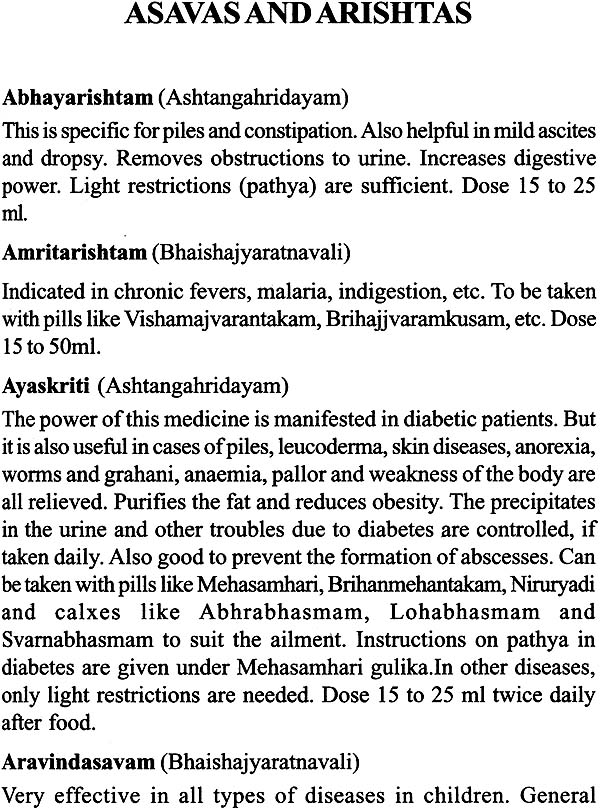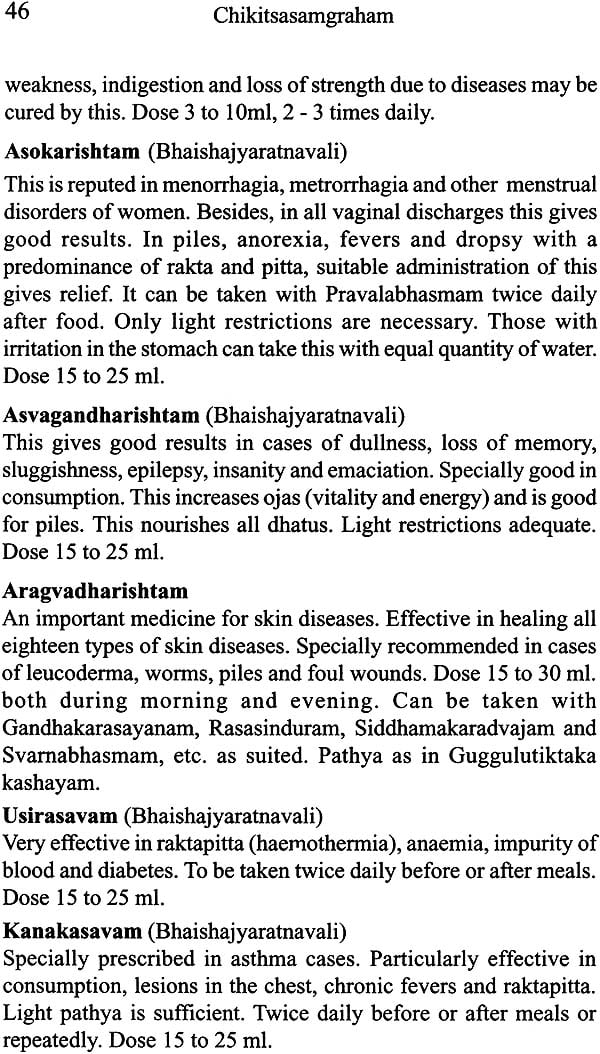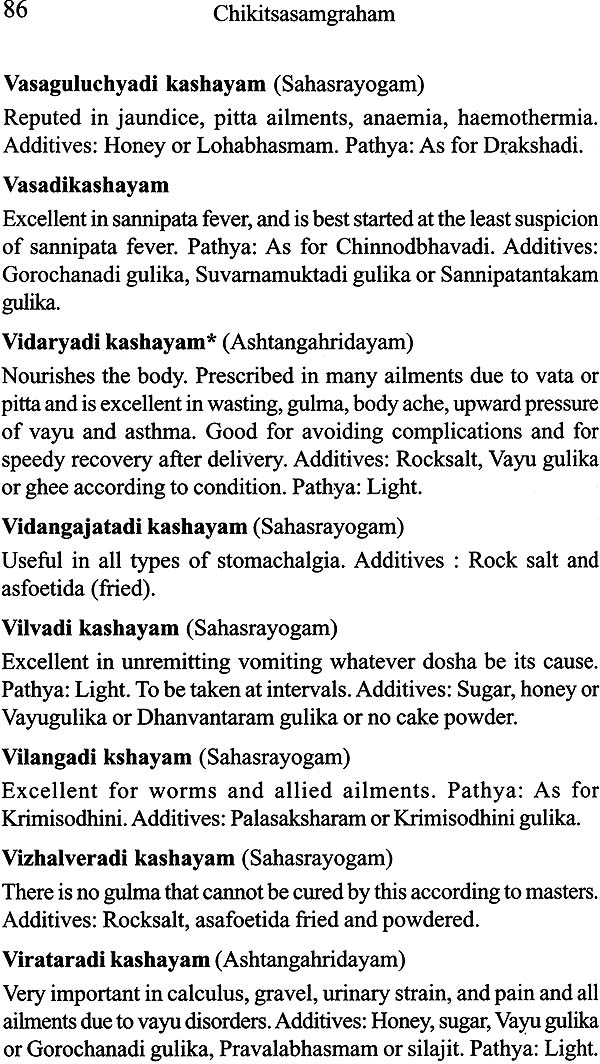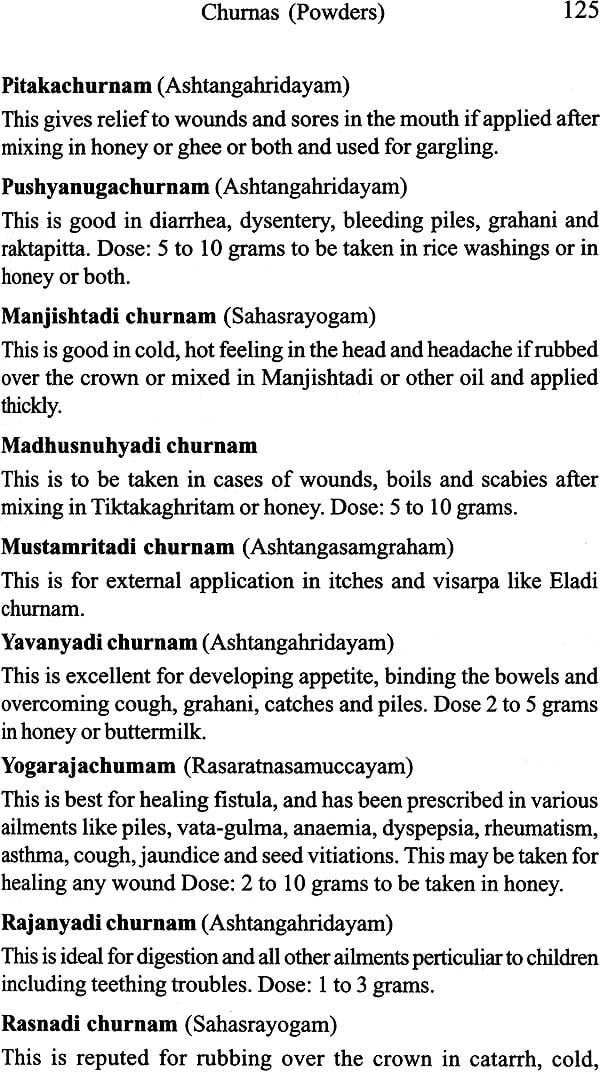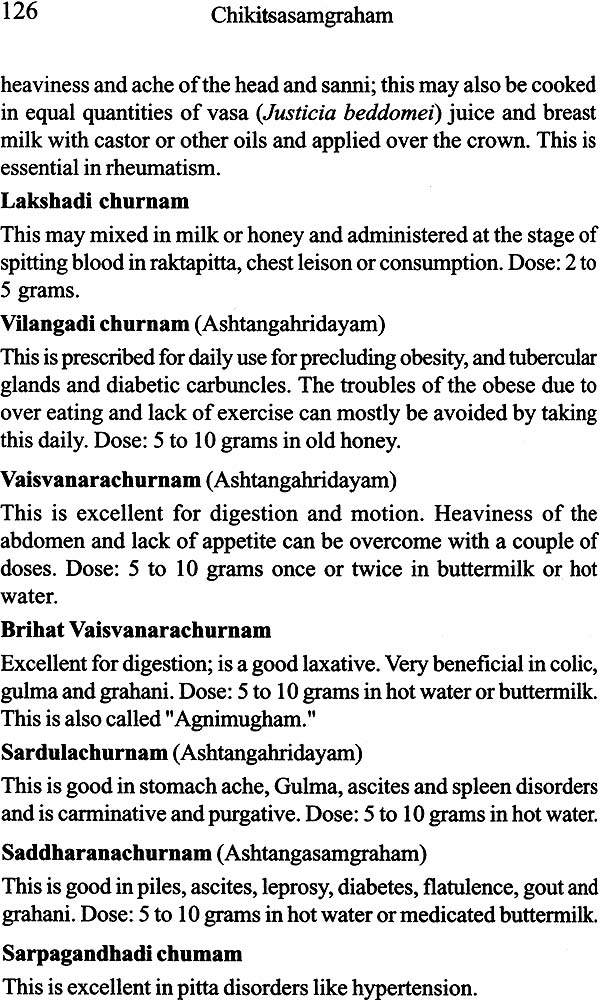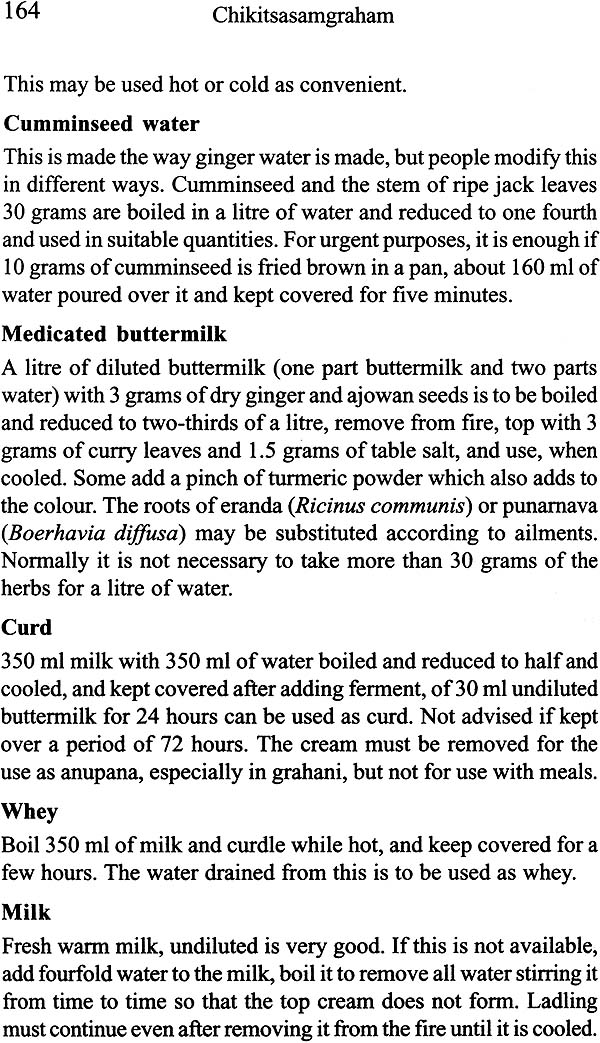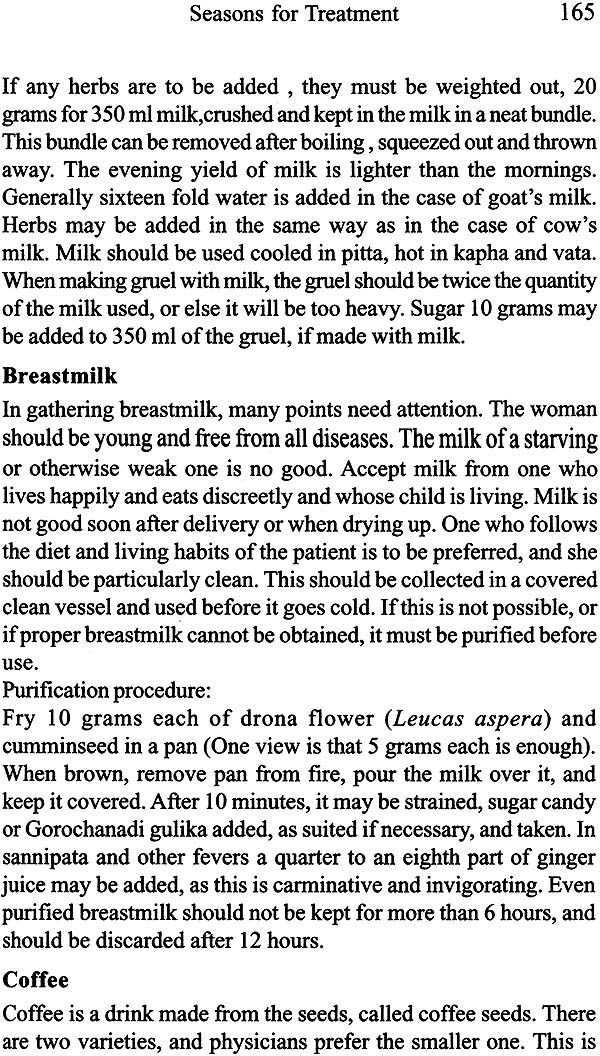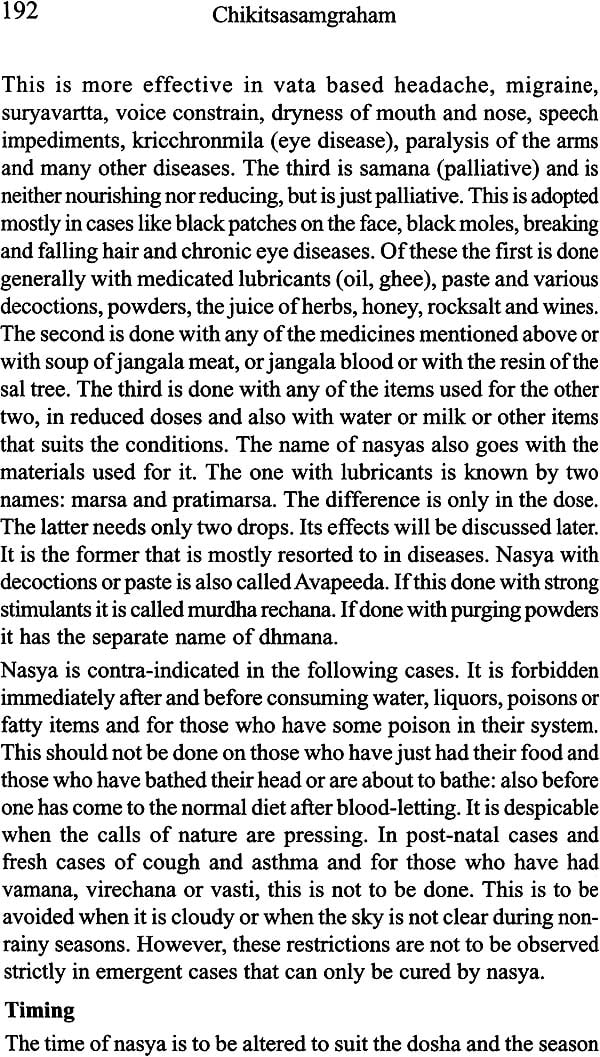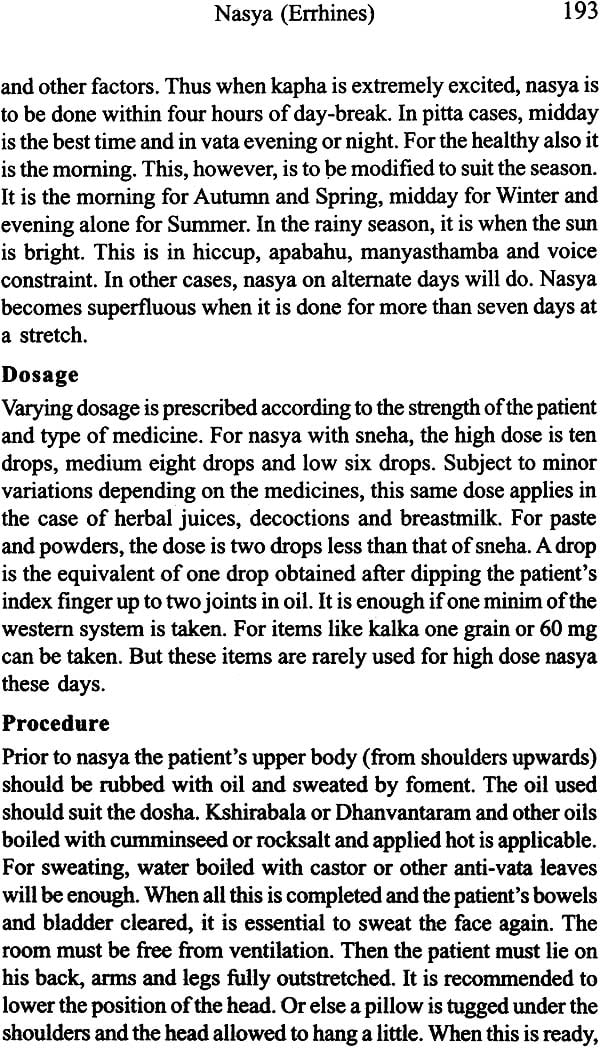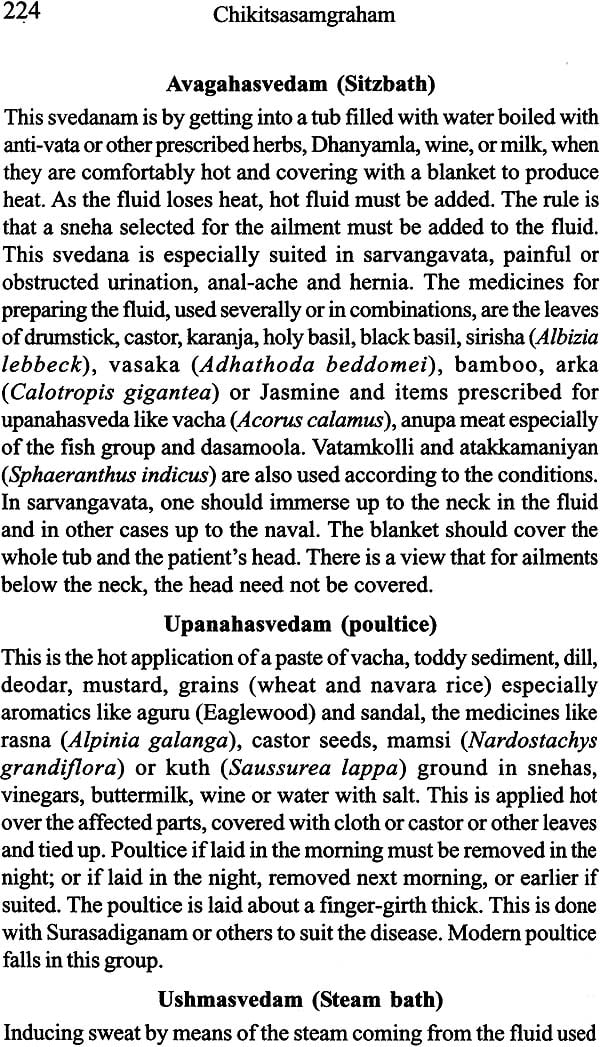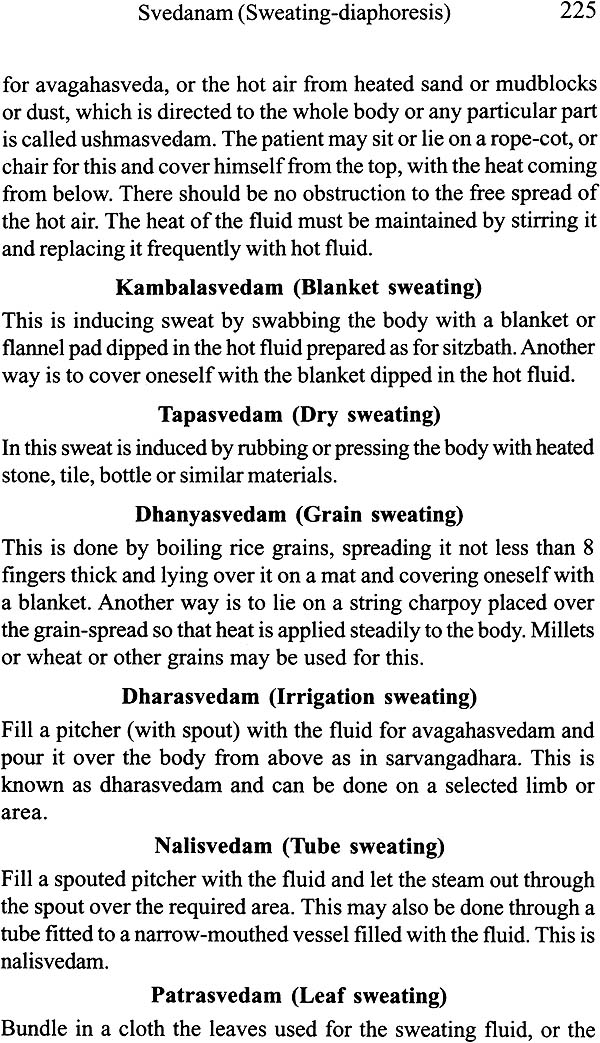
Chikitsa Samgraham
Book Specification
| Item Code: | IDC155 |
| Author: | P.S. Varier Translated by P.U.K. Warrier |
| Publisher: | Arya Vaidya Sala, Kottakkal |
| Language: | English |
| Edition: | 2019 |
| ISBN: | 9789380148687 |
| Pages: | 270 |
| Cover: | Paperback |
| Other Details | 8.5" X 5.0" |
| Weight | 230 gm |
Book Description
Preface
We are happy to bring out the English translation of Chikitsa Samgraham. Originally it was written in Malayalam by Vaidyaratnam P.S. Varier the most renowned and revered among those who pioneered the renaissance of Ayurveda. The first edition of this book in Malayalam was published by the author, the founder of Arya Vaidya Sala in 1907. The work is essential for physicians, and useful for patients. Even a layman can obtain some basic knowledge about the maintenance of health from this book. It is proof of its usefulness that the inquisitive welcome the work with interest and enthusiasm.
This book describes all popular medical formulations contained in the various texts and their various forms and combinations along with their dosage, methods of usage, dietary and other restrictions and their declared effects. It also describes the pathogenesis, symptoms and other details of common diseases and prescribes the treatment for them. Besides, there is a detailed description of Panchakarmas with their preparatory and concluding formalities, Dhara, Pizhichil and Navarakizhi which are the specialities of Kerala. It discusses all important aspects of the maintenance and promotion of health, such as regimen, diet and the suitable time and place for treatment.
We have had to make some alteration sin the original work. we have deleted some inconsequential medicines and added a few new ones.
It deserves special mention that an article by the author, entitled “The principles of Ayurveda” published in “Dhanwanthari” (Book 19 vol. 11 and 12) dated June 15 and July 16, 1922 is appended to this edition. It is hoped that the way the author endeavoured to synthesise traditional and modern principles will become clear from this article, and that the inquisitive will welcome this. In what circumstances and to solve what all problems was the Arya Vaidya Sala established have been clarified in the author’s preface to the first edition. Thanks to his drive and dedication, those problems were solved then. Today we have new problems facing Ayurveda. The countrywide inflation is one such. It has also become difficult to get herbs and drugs essential in the manufacture of medicines.
Though preliminary steps are already on for the large scale cultivation of herbs in a scientific manner, it is high time that the Government and private agencies urgently make efforts in this direction.
It is a happy augury that many new projects are being formulated by the Government for the development of Ayurveda. But it cannot be forgotten that there are many regulations that handicap the manufacture and distribution of medicines. Due to the general restrictions on Narcotics, it has become almost impossible to get drugs like hemp (Ganja) and opium, necessary for the manufacture of some Ayurvedic medicines at proper times and in adequate quantities and so we have been forced to discontinue the manufacture of some medicines.
It has already been stated that due to the unprincipled clearance of forests, the growth of herbs is diminishing. It is to be feared that if this trend continues, production of medicines will be handicapped, however much science may progress. We therefore entreat the Government to pay due attention to this matter. The public and their representatives must realize this, and press the Government to adopt appropriate remedial measures.
Since the use of advanced machinery and modern technology will help speed up production and improve the quality of medicines and reduce production cost, we have developed various equipments ever since 1850. The role of Sri P.M. Varier, the nephew of Vaidyaratnam P.S. Varier and the first Managing Trustee of the Arya Vaidya Sala (my elder brother) in embarking on this new venture is unforgettable. I take this opportunity to pay homage with folded hands to his sacred memory.
In bringing out the English translation of Chikitsa Samgraham, we are indebted to Major P.U.K. Warrier (Retd.). We take this opportunity to express our thanks to Mr. P.U.K. Warrier for the English translation of Chikitsa Samgraham.
Back of the Book
P.S. Varier was on 16-3-1869. He learned the theory and practice of Ayurveda in the traditional Gurukula System under Ashtavaidyan Kuttancheri Moose. He also had a basic training in the Allpathic System under Dr. V. Varghese, a reputed Physician and Surgeon of the Time. He founded the Arya vaidya sala at Kottakkal in 1902 and later the Ayurveda Pathasala in 1917. He edited and published “Dhanwanthari”, The first medical journal in Malayalam. He had authored classical treatises like Chikitsa Samgraham (Malayalam), Ashtanga Sareeram and Brihacchareeram (Sanskrit) and had also published several articles in medical journals. In 1907, he started a drama troupe which was later converted into the now famous Kathakali troupe, P.S.V. Natyasangam.
He was a nominated life - member of the Central Board of Indian Medicine since 1932. In 1933, the Government of India honoured him with the award of the prestigious Vaidtyaratnam little.
| Preface | i | |
| Preface to first Malayalam edition | iv | |
| Kottakkal Arya Vaidya Sala: A brief history of its progress | vii | |
| Principles of Ayurveda | xviii | |
| Guidelines for the storage of Medicines | 1 | |
| Guidelines for handling and serving medicines | 4 | |
| Arishtas and Asavas | 7 | |
| Tailam (Oil, Coconut oil, Kuzhampur etc.) | 15 | |
| Kashayam (Decoctions) | 33 | |
| Gulika, Vatakam, Vartti | 53 | |
| Ghritam (Ghee) | 70 | |
| Churnam (Powder) | 85 | |
| Bhasmam (Calxes) | 94 | |
| Rasakriya (Collyriums) | 103 | |
| Lehyam (Electuaries) | 105 | |
| Additives | 113 | |
| Duties of the patients | 116 | |
| Seasons for treatment | 119 | |
| 1 | Region | 121 |
| 2 | Pathyam (Regimen) | 121 |
| 3 | Icchapathyam (Affable regimen) | 123 |
| 4 | Kricchrapathyam (Austere regimen) | 124 |
| 5 | Dosage | 125 |
| 6 | Aupanam (Adjuvants) | 126 |
| a. Water | 127 | |
| b. Ginger water | 127 | |
| c. Cumin seed water | 127 | |
| d. Medicated buttermilk | 128 | |
| e. Curd | 128 | |
| f. Whey | 128 | |
| g. Milk | 128 | |
| h. Breast milk | 129 | |
| i. Coffee | 129 | |
| j. Tea | 130 | |
| k. Dhanyamlam | 131 | |
| Instructions for treatment | 132 | |
| 1. | Abhyangam (Inunction) | 132 |
| 2. | Dhara | 133 |
| 3. | Moordhanya dhara | 134 |
| 4. | Dharappatti | 134 |
| 5. | Dharaccatti | 135 |
| 6. | Dharadravam | 136 |
| 7. | Takradhara (Dhara with buttermilk) | 136 |
| 8. | Kshiradhara (Dhara with milk) | 137 |
| 9. | Stanya dhara (Dhara with breastmilk) | 138 |
| 10. | Snehadhara (Dhara with unguents) | 138 |
| 11. | Attendants | 139 |
| 12. | Physician | 139 |
| 13. | Bed sheet | 140 |
| 14. | Pillow | 140 |
| 15. | Vartti (Roll of cloth) | 141 |
| 16. | Oil for the head | 141 |
| 17. | Kuzhampu for the body | 141 |
| 18. | Gooseberry water | 141 |
| 19. | Hot water | 142 |
| 20. | Powder for rubbing on the crown | 142 |
| 21. | Medicines for intake | 142 |
| 22. | Procedure of treatment | 142 |
| 23. | Sarvangadhara | 147 |
| 24. | Ekangadhara | 149 |
| 25. | Dhara in the eyes | 149 |
| 26. | Pizhiccil | 150 |
| 27. | Duties after Dhara | 151 |
| 28. | Restrictions during Dhara | 152 |
| Nasyam | 155 | |
| 1. | Timing | 156 |
| 2. | Dosage | 157 |
| 3. | Procedure | 157 |
| 4. | Pratimarsam | 159 |
| Picu | 161 | |
| 1 | Procedure | 161 |
| Tala Poticil | 161 | |
| 1. | Equipments | 161 |
| 2. | Procedure | 162 |
| Vamanam | 163 | |
| 1. | Procedure | 165 |
| Peyadikramam | 167 | |
| Virecanam | 169 | |
| 1. | Procedure | 169 |
| Vasti | 173 | |
| 1. | Procedure | 174 |
| 2. | Snehavasti | 174 |
| 3. | Kashayavasti | 175 |
| 4. | Uttaravasti | 176 |
| 5. | Matravasti | 176 |
| Sirovasti | ||
| 1. | Procedure | 178 |
| Snanam | 181 | |
| Snehanam | 184 | |
| Svedanam | 188 | |
| 1. | Avagahasvedam | 188 |
| 2. | Upanahasvedam | 189 |
| 3. | Ushmasvedam | 189 |
| 4. | Kambalasvedam | 190 |
| 5. | Tapasvedam | 190 |
| 6. | Dhanyasvedam | 190 |
| 7. | Dharasvedam | 190 |
| 8. | Nalisvedam | 190 |
| 9. | Patrasvedam | 190 |
| 10. | Pindasvedam | 191 |
| a. Equipments | 191 | |
| b. Procedure | 191 | |
| Common diseases and their treatments | 195 | |
| Patient’s letters | 233 |
